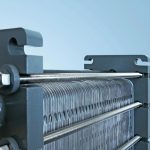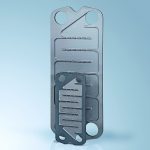There are many criteria such as size/footprint, weight, heat transfer area, volume, fouling factors or cleaning effort where plate heat exchangers are superior to classic shell-and-tube apparatus. For example, the average space requirement is 40 to 50 % less and sometimes even more, depending on the application. The plates have usually a wall thickness of 1 to 2 mm, allowing efficient manufacturing by forming. The range of materials in this production process is limited to stainless steels, special alloys, copper, titanium and other ductile metals. However, these materials have only limited chemical resistance, especially in extremely corrosive applications. It therefore makes sense to combine the design advantages with the almost universal chemical and abrasion resistance of the ceramic silicon carbide material. The corrosion rate is mostly well under 10 mg/cm2a, even when exposed to severe chemical stress. It is the modification that is decisive, though: this excellent, practically universal chemical resistance is only offered by directly sintered alpha silicon carbide, otherwise known as SSiC.
Meandering channel structure
Yet the use of ceramic materials requires a rethink in terms of manufacturing technology. The silicon carbide plates are moulded by machining the so called green body, i. e. the isostatically pressed but not yet sintered plates. Depending on their size and design, these plates have a total thickness of approximately 6 to 10 mm, from which the channel cavity for the media is machined on the inside. The channel surface has profiles for guiding the flow, producing turbulence and supporting the channel against the next plate. The meandering channel structure ensures efficient utilisation of the heat transfer area without short circuits or dead spaces. Other design elements can be implemented depending on the plate size and the requirements of the application.
The basic concept for plate heat exchangers made from SSiC was developed to market maturity by 3M Technical Ceramics, formerly ESK Kempten. The material-specific manufacturing challenges were a key priority. When the series was taken over by GAB Neumann, the latter‘s long-standing application expertise and experience in classic chemical apparatus came into play. This heat exchanger type complements the Corresic product family with shell-and-tube and block-type SSiC heat exchangers. As part of the transfer, the product was optimised and its overall structure adapted to the application requirements.
Universal corrosion resistance
The 3M SiC Type C plate material is a pressureless sintered SSiC with universal corrosion resistance. The maximum dimensions of ceramic plates are limited compared to metal apparatus. There are two reasons for this: firstly, the green body must be sintered at approximately 2000 °C, so that larger plates are ruled out by the complex sintering equipment, and secondly, the effectiveness of the plate principle, namely between two and four times more heat transfer than with other classical heat exchanger types. High transfer rates can thus be achieved with small heat transfer capacities. Three series (plate sizes 260 x 120, 500 x 200 and 585 mm x 250 mm) currently exist. The apparatus meets even the highest hygienic standards, e. g. the German KTW, and can optionally be supplied with an FDA compliant design.
Potential applications
Silicon carbide material is primarily used in highly corrosive and/or abrasive process conditions for economic reasons. Providing it is appropriately prepared, it is also suitable for high-purity processes (up to ppt) due to the fact that there is no risk of contamination or emissions. The Corresic portfolio of silicon carbide heat exchangers now includes SR shell-and-tube type exchangers, SE block heat exchangers and SP plate apparatus. The SP plate type is ideal for high-performance applications with low-to-medium mass flow rates. The dilution of highly concentrated sulphuric acid, for example, goes hand in hand with a relatively high mixing temperature. Although the acid rates are often low (a few m3/h), so that a small cross-section is called for, the large target temperature differences (about 100 to 140 °C) result in a high capacity and comparatively large transfer area. In such situations, both tube bundle and block apparatus usually require multiple passes that enlarge the transfer area still further because the mean temperature difference is reduced. In many cases, multiple devices must be connected in series to provide the required cooling capacity or heat transfer area. A whole set of applications, particularly if there are temperature overlaps, are problematic if not impossible with shell-and-tube or block apparatus.
Compact plate apparatus
SiC plate heat exchangers allow a high degree of variability as well as easy implementation of multi-channel functionality in the apparatus. This is impressively demonstrated by the example of 70% sulphuric acid cooling, where a temperature difference of 140 °C/45 °C must be realised with cooling water at 25 °C/38 °C. Two very long, slender shell-and-tube units (DN 125, each 4.5 m long), can be replaced with a very compact plate apparatus just 0.6 x 0.6 x 0.35 m in size. The plate apparatus has a heat transfer area equivalent to just under 30 % of entire transfer area of both shell-and-tube units. The heat transfer coefficient, too, is inversely proportional. A total of 34 SiC tubes 14 x 1.5 mm/4.0 m long were compared with 30 SiC plates measuring 500 x 200 x 7 mm. The same applies to applications with higher or high-viscosity media, where the advantages of plate heat exchangers are similarly clear.
In a SiC plate heat exchanger installation, consisting of four apparatus for preheating and cooling a specific sulphuric acid product, huge graphite shell-and-tube units were successfully replaced with SiC plate exchangers with heat transfer areas of between 1.5 and 2.5 m2 and operating temperatures from 15 to 150 °C.
Online search: cpp0317gabneumann










